Simulation/Experiment Confrontation, an Efficient Approach for Sensitive SAW Sensors Design
Abstract
1. Introduction
2. Materials and Methods
2.1. Chemicals
2.2. Gravimetric Measurements
3. Results and Discussion
3.1. Analytical Modeling Using MATLAB Software
3.2. Numerical Simulation with COMSOL Multiphysics
3.3. SAW Device Sensitivity Enhancement with Operating Frequency Increase
3.4. Design of TDP-AN SAW Sensors
3.4.1. Functionalization Step
3.4.2. Zn2+ Detection
4. Conclusions
Supplementary Materials
Author Contributions
Funding
Acknowledgments
Conflicts of Interest
References
- Campbell, C. Surface Acoustic Wave Devices and Their Signal Processing Applications, 1st ed.; Academic Press: San Diego, CA, USA, 1989. [Google Scholar]
- Campbell, C. Surface Acoustic Wave Devices for Mobile and Wireless Communications; Academic Press: San Diego, CA, USA, 1998. [Google Scholar]
- Hashimoto, K.-Y. Surface Acoustic Wave Devices in Telecommunications: Modelling and Simulation; Springer: Berlin/Heidelberg, Germany, 2000. [Google Scholar]
- Gell, J.R.; Ward, M.B.; Young, R.J.; Stevenson, R.M.; Atkinson, P.; Anderson, D.; Jones, G.A.; Ritchie, D.A.; Shields, A.J. Modulation of single quantum dot energy levels by a surface-acoustic-wave. Appl. Phys. Lett. 2008, 93, 081115. [Google Scholar] [CrossRef]
- Aigner, R. SAW and BAW technologies for RF filter applications: A review of the relative strengths and weaknesses. In Proceedings of the 2008 IEEE Ultrasonics Symposium, Beijing, China, 2–5 November 2008; pp. 582–589. [Google Scholar]
- Xuan, W.; He, M.; Meng, N.; He, X.; Wang, W.; Chen, J.; Shi, T.; Hasan, T.; Xu, Z.; Xu, Y.; et al. Fast Response and High Sensitivity ZnO/glass Surface Acoustic Wave Humidity Sensors Using Graphene Oxide Sensing Layer. Sci. Rep. 2014, 4, 7206. [Google Scholar] [CrossRef]
- Morales-Rodríguez, M.E.; Joshi, P.C.; Humphries, J.R.; Fuhr, P.L.; Mcintyre, T.J. Fabrication of Low Cost Surface Acoustic Wave Sensors Using Direct Printing by Aerosol Inkjet. IEEE Access 2018, 6, 20907–20915. [Google Scholar] [CrossRef]
- Tang, Y.-L.; Li, Z.-J.; Ma, J.-Y.; Su, H.-Q.; Guo, Y.-J.; Wang, L.; Du, B.; Chen, J.-J.; Zhou, W.; Yu, Q.-K.; et al. Highly sensitive room-temperature surface acoustic wave (SAW) ammonia sensors based on Co3O4/SiO2 composite films. J. Hazard. Mater. 2014, 280, 127–133. [Google Scholar] [CrossRef]
- Tang, Y.; Li, Z.; Ma, J.; Wang, L.; Yang, J.; Du, B.; Yu, Q.; Zu, X. Highly sensitive surface acoustic wave (SAW) humidity sensors based on sol–gel SiO2 films: Investigations on the sensing property and mechanism. Sens. Actuators B Chem. 2015, 215, 283–291. [Google Scholar] [CrossRef]
- Eun, K.; Lee, K.J.; Lee, K.K.; Yang, S.S.; Choa, S.-H. Highly sensitive surface acoustic wave strain sensor for the measurement of tire deformation. Int. J. Precis. Eng. Manuf. 2016, 17, 699–707. [Google Scholar] [CrossRef]
- Vanotti, M.; Blondeau-Patissier, V.; Rauch, J.-Y.; Rabus, D.; Mazal, B.; Ballandras, S. SAW sensor exploiting palladium layer properties for selective detection of hydrogen. In Proceedings of the 2013 Joint European Frequency and Time Forum & International Frequency Control Symposium (EFTF/IFC), IEEE, Prague, Czech Republic, 21–25 July 2013; pp. 775–778. [Google Scholar]
- Kabir, K.M.M.; Sabri, Y.M.; Matthews, G.I.; Jones, L.A.; Ippolito, S.J.; Bhargava, S.K. Selective detection of elemental mercury vapor using a surface acoustic wave (SAW) sensor. Analyst 2015, 140, 5508–5517. [Google Scholar] [CrossRef]
- Achour, B.; Mazouz, Z.; Fourati, N.; Zerrouki, C.; Aloui, N.; Yaakoubi, N.; Othmane, A.; Kalfat, R. Ultrasensitive Ion Imprinted Polypyrole Polymer Based Piezoelectric Sensors for Selective Detection of Lead Ions. In Proceedings of the 2018 IEEE SENSORS, New Delhi, India, 28–31 October 2018; pp. 1–4. [Google Scholar]
- Liu, X.; Wang, W.; Zhang, Y.; Pan, Y.; Liang, Y.; Li, J. Enhanced Sensitivity of a Hydrogen Sulfide Sensor Based on Surface Acoustic Waves at Room Temperature. Sensors 2018, 18, 3796. [Google Scholar] [CrossRef]
- Nikolaou, I.; Hallil, H.; Plano, B.; Deligeorgis, G.; Conedera, V.; Garcia, H.; Dejous, C.; Rebière, D. Drop-casted Graphene Oxide Love wave sensor for detection of humidity and VOCs. J. Integr. Circuits Syst. 2016, 11, 49–56. [Google Scholar]
- Mensah-Brown, A.K.; Wenzel, M.J.; Josse, F.J.; Yaz, E.E. Near Real-Time Monitoring of Organophosphate Pesticides in the Aqueous-Phase Using SH-SAW Sensors Including Estimation-Based Signal Analysis. IEEE Sens. J. 2009, 9, 1817–1824. [Google Scholar] [CrossRef]
- Hashimoto, K.; Yamaguchi, M. Delta function model analysis of SSBW spurious response in SAW devices. In Proceedings of the 1993 IEEE International Frequency Control Symposium, Salt Lake City, UT, USA, 2–4 June 1993; pp. 639–644. [Google Scholar]
- Hachigo, A.; Malocha, D.C. SAW dispersive equivalent circuit modeling for diamond layered structures. In Proceedings of the 1996 IEEE Ultrasonics Symposium, San Antonio, TX, USA, 3–6 November 1996; pp. 151–154. [Google Scholar]
- Kovacs, G. A generalised P-matrix model for SAW filters. In Proceedings of the 2003 IEEE Symposium on Ultrasonics, Honolulu, HI, USA, 5–8 October 2003; pp. 707–710. [Google Scholar]
- Hashimoto, K.; Omori, T.; Yamaguchi, M. Modelling of shear-horizontal-type surface acoustic waves and its application to COM-based device simulation. In Proceedings of the 2001 IEEE Ultrasonics Symposium, Atlanta, GA, USA, 7–10 October 2001; pp. 127–132. [Google Scholar]
- Zakaria, M.R.; Hashim, U.; Amin, M.H.I.M.; Ayub, R.M.; Hashim, M.N.; Adam, T. Design and simulation study of high frequency response for surface acoustic wave device by using CST software. AIP Conf. Proc. 2015, 1660, 090043. [Google Scholar]
- Achour, B.; Aloui, N.; Fourati, N.; Zerrouki, C.; Yaakoubi, N. Modelling and simulation of SAW delay line sensors with COMSOL Multiphysics. In Proceedings of the MOL2NET 2018, International Conference on Multidisciplinary Sciences, 4th Edition Session BIOCHEMPHYS-01: International Workshop on Med. Chem., Biotech., and Phys. Chem., CNAM, Paris, France, 7 December 2018. [Google Scholar] [CrossRef]
- Elhosni, M.; Elmazria, O.; Petit-Watelot, S.; Bouvot, L.; Zhgoon, S.; Talbi, A.; Hehn, M.; Aissa, K.A.; Hage-Ali, S.; Lacour, D.; et al. Magnetic field SAW sensors based on magnetostrictive-piezoelectric layered structures: FEM modeling and experimental validation. Sens. Actuators Phys. 2016, 240, 41–49. [Google Scholar] [CrossRef]
- Wang, T.; Green, R.; Guldiken, R.; Wang, J.; Mohapatra, S.; Mohapatra, S.S. Finite Element Analysis for Surface Acoustic Wave Device Characteristic Properties and Sensitivity. Sensors 2019, 19, 1749. [Google Scholar] [CrossRef] [PubMed]
- Nikolaou, I.; Hallil, H.; Tamarin, O.; Dejous, C.; Rebiere, D. A three-dimensional model for a graphene guided SH-SAW sensor using finite element method. In Proceedings of the 2016 31st Symposium on Microelectronics Technology and Devices (SBMicro), Belo Horizonte, Brazil, 29 August–3 September 2016; pp. 1–4. [Google Scholar]
- Tamarin, O.; Rube, M.; Boissiere, C.; Lachaud, J.L.; Hallil, H.; Dejous, C.; Rebiere, D. Finite Element Modelling design and optimization of Love Wave mesoporous transducers for biochemical detection in liquid medium. In Proceedings of the 2018 3rd International Symposium on Instrumentation Systems, Circuits and Transducers (INSCIT), Bento Goncalves, Brazil, 27–31 August 2018; pp. 1–6. [Google Scholar]
- Abdollahi, A.; Jiang, Z.; Arabshahi, S.A. Evaluation on mass sensitivity of SAW sensors for different piezoelectric materials using finite-element analysis. IEEE Trans. Ultrason. Ferroelectr. Freq. Control 2007, 54, 2446–2455. [Google Scholar] [CrossRef]
- Zhao, Y.-G.; Liu, M.; Li, D.-M.; Li, J.-J.; Niu, J.-B. FEM modeling of SAW organic vapor sensors. Sens. Actuators Phys. 2009, 154, 30–34. [Google Scholar] [CrossRef]
- Richardson, M.; Sankaranarayanan, S.K.R.S.; Bhethanabotla, V.R. Low Insertion Loss and Highly Sensitive SH-SAW Sensors Based on 36° YX LiTaO3 Through the Incorporation of Filled Microcavities. IEEE Sens. J. 2015, 15, 787–796. [Google Scholar] [CrossRef]
- Abraham, N.; Reshma Krishnakumar, R.; Unni, C.; Philip, D. Simulation studies on the responses of ZnO-CuO/CNT nanocomposite based SAW sensor to various volatile organic chemicals. J. Sci. Adv. Mater. Devices 2019, 4, 125–131. [Google Scholar] [CrossRef]
- Thirumal, V.; Raju, B.; Gandhi, P.; Pandya, H.M. Comparative Modelling Studies of 400 MHz ST-X Quartz SAW Delay Lines for Potential Gas Sensing Applications. Arch. Acoust. 2018, 43, 153–161. [Google Scholar]
- Sarthe Department–River Management Office-Water Legislation Dossier–Waterways-29/10/2018. Available online: http://www.sarthe.gouv.fr/IMG/pdf/dossier_loisurleau_entretienvoiesnavigables_vf.pdf (accessed on 30 June 2020).
- Behnia, N.; Asgari, M.; Feizbakhsh, A. Sub-nanomolar detection of zinc on the ion-imprinted polymer modified glassy carbon electrode. J. Environ. Chem. Eng. 2015, 3, 271–276. [Google Scholar] [CrossRef]
- Hande, P.E.; Samui, A.B.; Kulkarni, P.S. Highly selective monitoring of metals by using ion-imprinted polymers. Environ. Sci. Pollut. Res. 2015, 22, 7375–7404. [Google Scholar] [CrossRef]
- Kuras, M.J.; Perz, K.; Kołodziejski, W.L. Synthesis, characterization and application of a novel zinc(II) ion-imprinted polymer. Polym. Bull. 2017, 74, 5029–5048. [Google Scholar] [CrossRef]
- Xu, J.; Sun, Y.; Sheng, Y.; Fei, Y.; Zhang, J.; Jiang, D. Engineering a DNA-cleaving DNAzyme and PCR into a simple sensor for zinc ion detection. Anal. Bioanal. Chem. 2014, 406, 3025–3029. [Google Scholar] [CrossRef] [PubMed]
- Wen, J.T.; Bohorquez, K.; Tsutsui, H. Polydiacetylene-coated polyvinylidene fluoride strip aptasensor for colorimetric detection of zinc(II). Sens. Actuators B Chem. 2016, 232, 313–317. [Google Scholar] [CrossRef] [PubMed]
- Rigo, A.A.; Cezaro, A.M.D.; Muenchen, D.K.; Martinazzo, J.; Manzoli, A.; Steffens, J.; Steffens, C. Heavy metals detection in river water with cantilever nanobiosensor. J. Environ. Sci. Health Part B 2020, 55, 239–249. [Google Scholar] [CrossRef] [PubMed]
- Xu, H.; Wang, H.; Zhou, S.; Xiao, L.; Yan, Y.; Yuan, Q. A protocol of self-assembled monolayers of fluorescent block molecules for trace Zn(II) sensing: Structures and mechanisms. RSC Adv. 2015, 5, 106061–106067. [Google Scholar] [CrossRef]
- Rigo, A.A.; de Cezaro, A.M.; Muenchen, D.K.; Martinazzo, J.; Brezolin, A.N.; Hoehne, L.; Steffens, J.; Steffens, C. Cantilever nanobiosensor based on the enzyme urease for detection of heavy metals. Braz. J. Chem. Eng. 2019, 36, 1429–1437. [Google Scholar]
- Turdean, G.L. Design and Development of Biosensors for the Detection of Heavy Metal Toxicity. Int. J. Electrochem. 2011, 2011, 343125. [Google Scholar] [CrossRef]
- Eddaif, L.; Shaban, A.; Telegdi, J. Sensitive detection of heavy metals ions based on the calixarene derivatives-modified piezoelectric resonators: A review. Int. J. Environ. Anal. Chem. 2019, 99, 824–853. [Google Scholar] [CrossRef]
- Zhang, H.; Faye, D.; Zhang, H.; Lefevre, J.-P.; Delaire, J.A.; Leray, I. Selective detection of heavy metal ions by calixarene-based fluorescent molecular sensors. In Proceedings of the SPIE, Advanced Environmental, Chemical, and Biological Sensing Technologies IX, Baltimore, MD, USA, 23–27 April 2012; Volume 8366, p. 83660I. [Google Scholar]
- Nikolelis, D.P.; Raftopoulou, G.; Psaroudakis, N.; Nikoleli, G.-P. Development of an electrochemical chemosensor for the rapid detection of zinc based on air stable lipid films with incorporated calix4arene phosphoryl receptor. Int. J. Environ. Anal. Chem. 2009, 89, 211–222. [Google Scholar] [CrossRef]
- Yang, R.; Li, K.; Wang, K.; Zhao, F.; Li, N.; Liu, F. Porphyrin Assembly on β-Cyclodextrin for Selective Sensing and Detection of a Zinc Ion Based on the Dual Emission Fluorescence Ratio. Anal. Chem. 2003, 75, 612–621. [Google Scholar] [CrossRef]
- Mazouz, Z.; Rahali, S.; Fourati, N.; Zerrouki, C.; Aloui, N.; Seydou, M.; Yaakoubi, N.; Chehimi, M.; Othmane, A.; Kalfat, R. Highly Selective Polypyrrole MIP-Based Gravimetric and Electrochemical Sensors for Picomolar Detection of Glyphosate. Sensors 2017, 17, 2586. [Google Scholar] [CrossRef] [PubMed]
- Hartmann, C.S.; Bell, D.T.; Rosenfeld, R.C. Impulse Model Design of Acoustic Surface-Wave Filters. IEEE Trans. Microw. Theory Tech. 1973, 21, 162–175. [Google Scholar] [CrossRef]
- Kurganov, B.I.; Lobanov, A.V.; Borisov, I.A.; Reshetilov, A.N. Criterion for Hill equation validity for description of biosensor calibration curves. Anal. Chim. Acta 2001, 427, 11–19. [Google Scholar] [CrossRef]
- Penza, M.; Rossi, R.; Alvisi, M.; Aversa, P.; Cassano, G.; Suriano, D.; Benetti, M.; Cannata, D.; Di Pietrantonio, F.; Verona, E. SAW Gas Sensors with Carbon Nanotubes Films. In Proceedings of the 2008 IEEE Ultrasonics Symposium, Beijing, China, 2–5 November 2008; pp. 1850–1853. [Google Scholar]
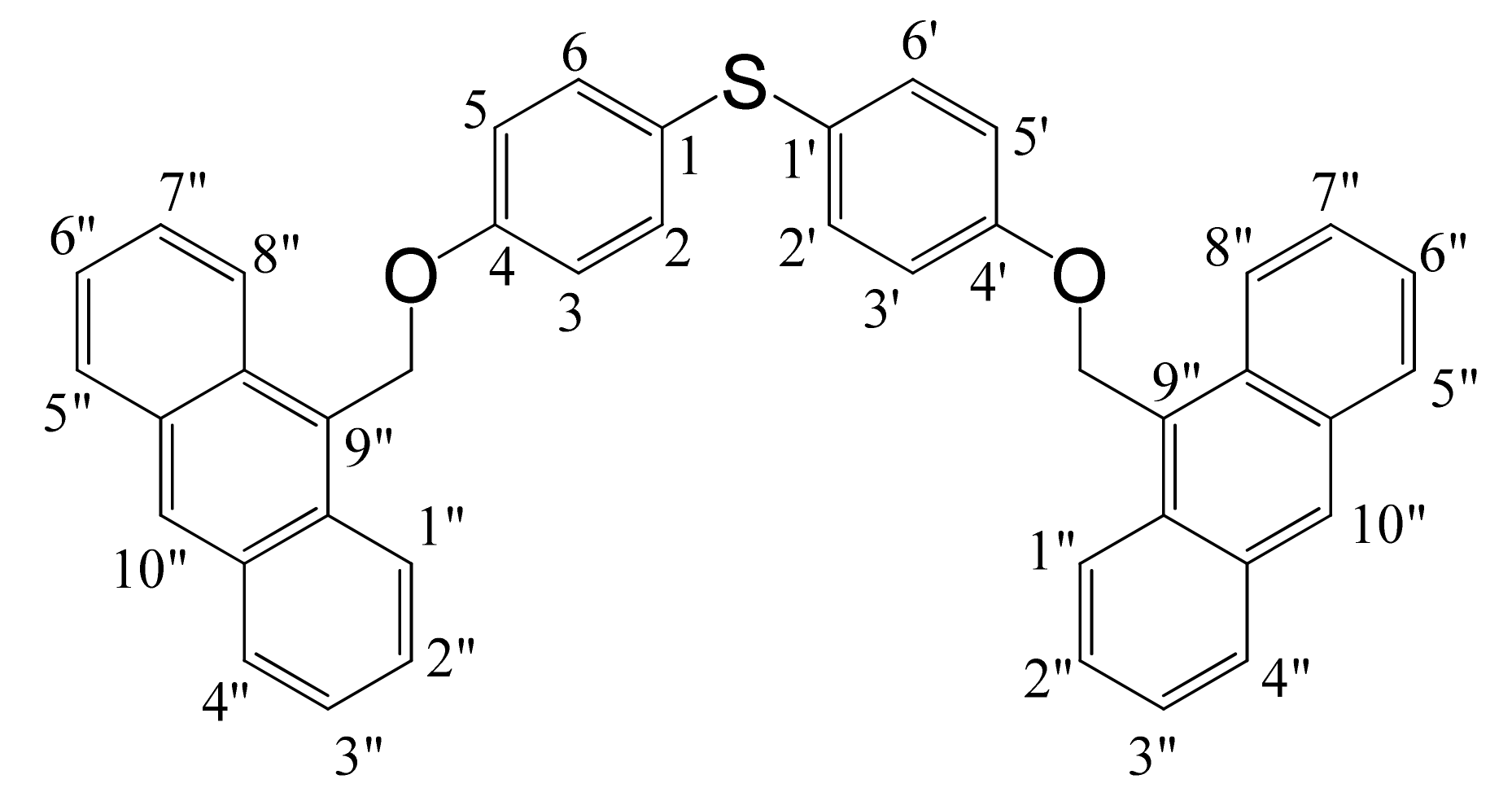

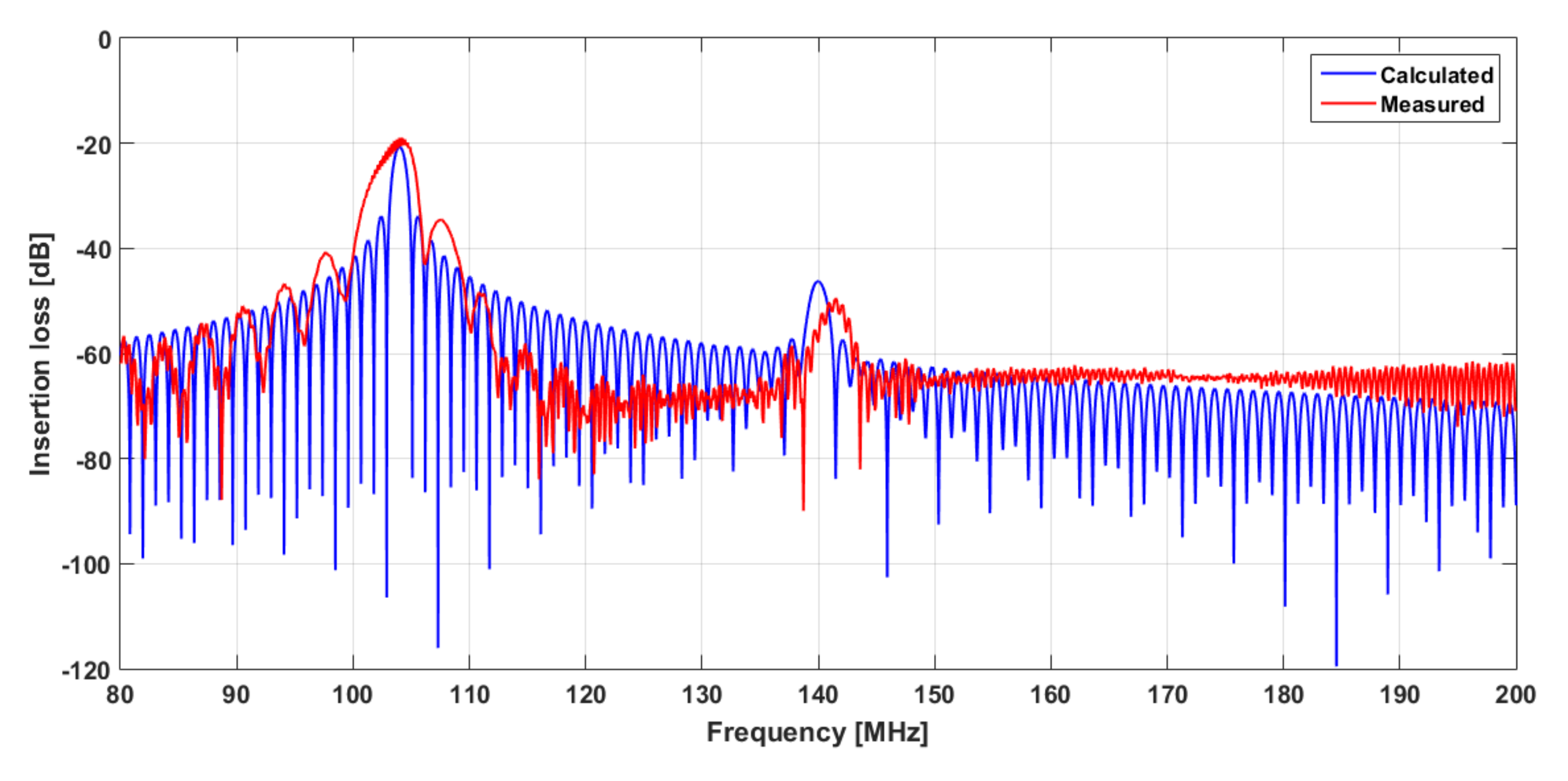
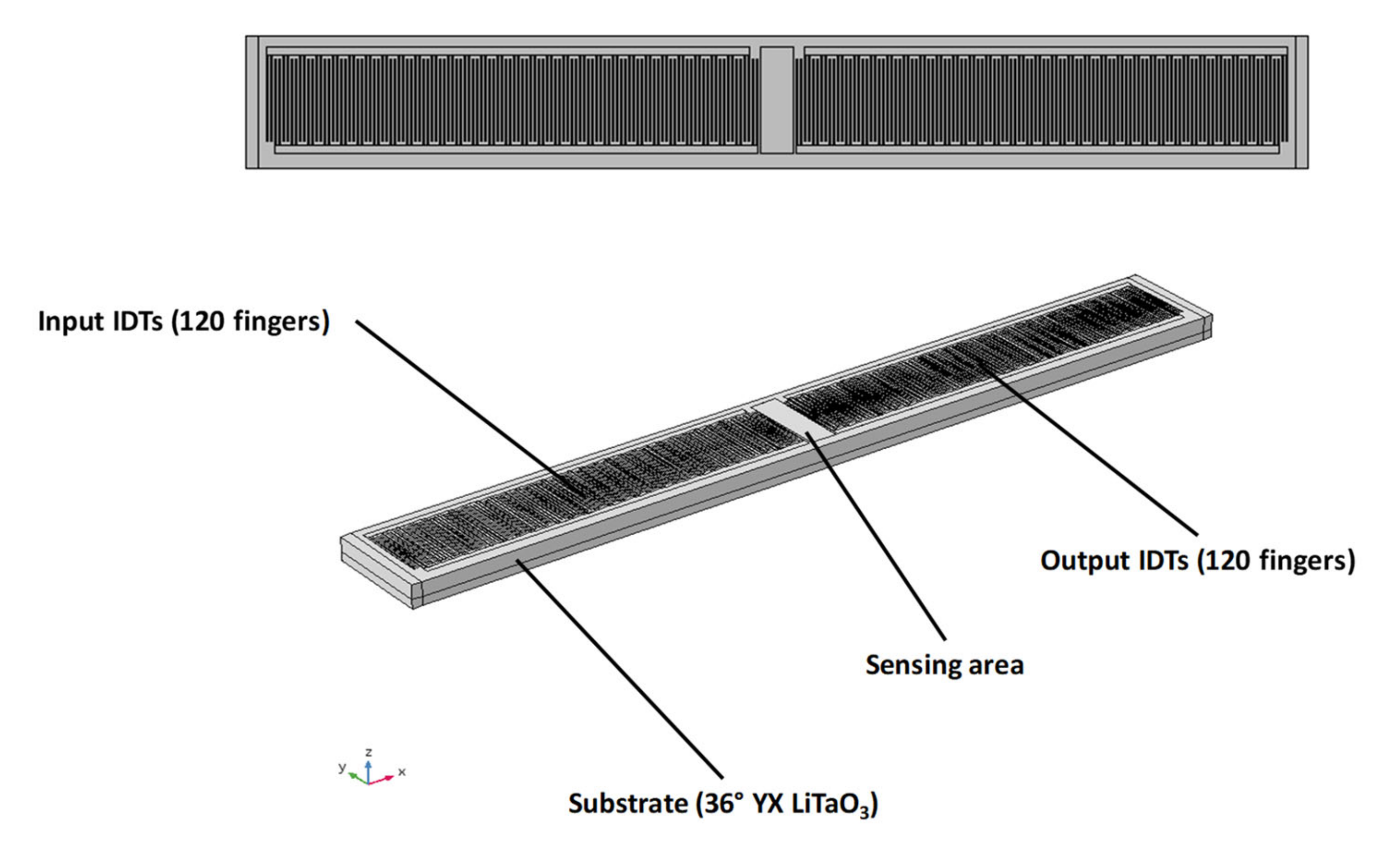

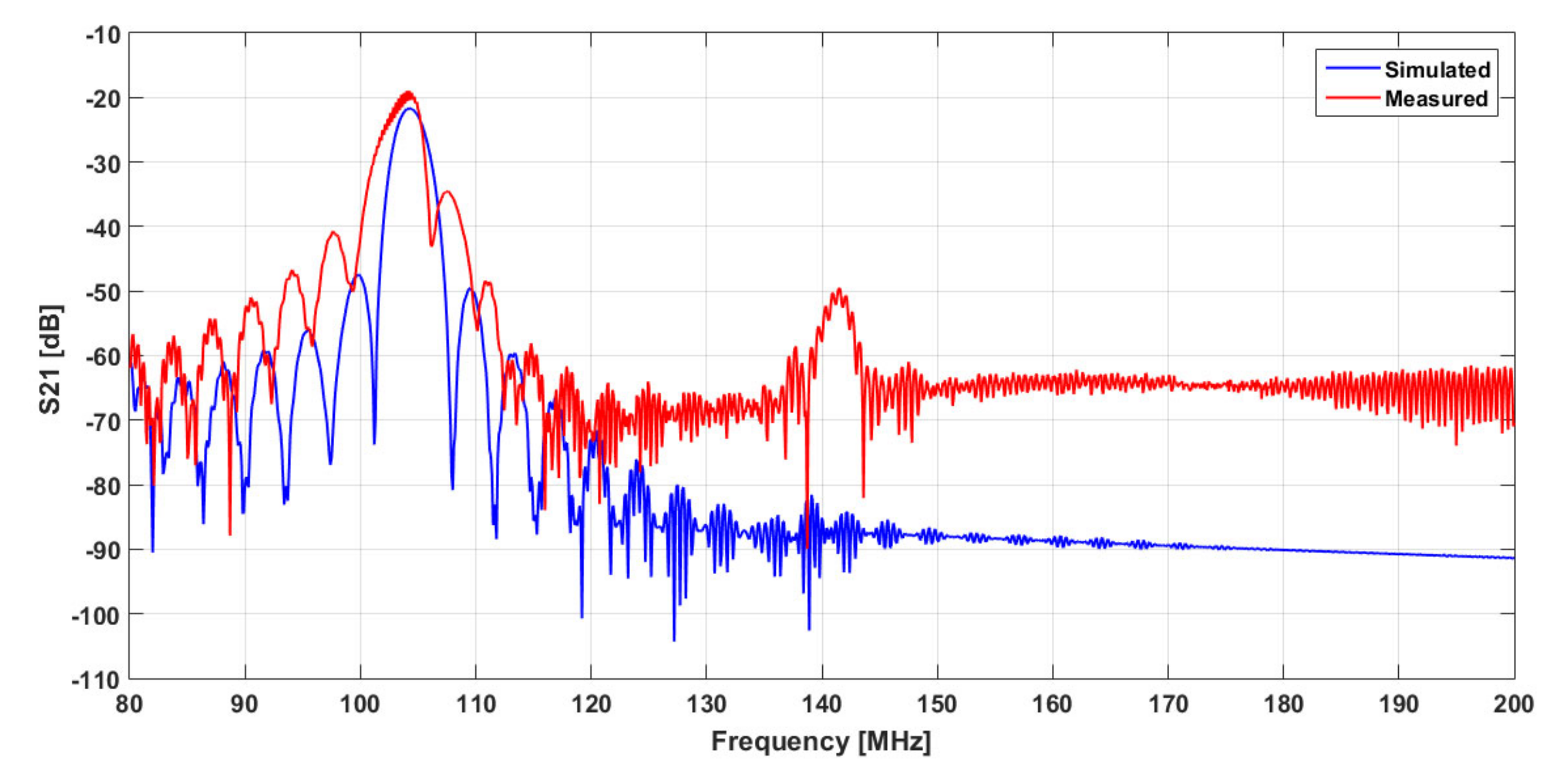
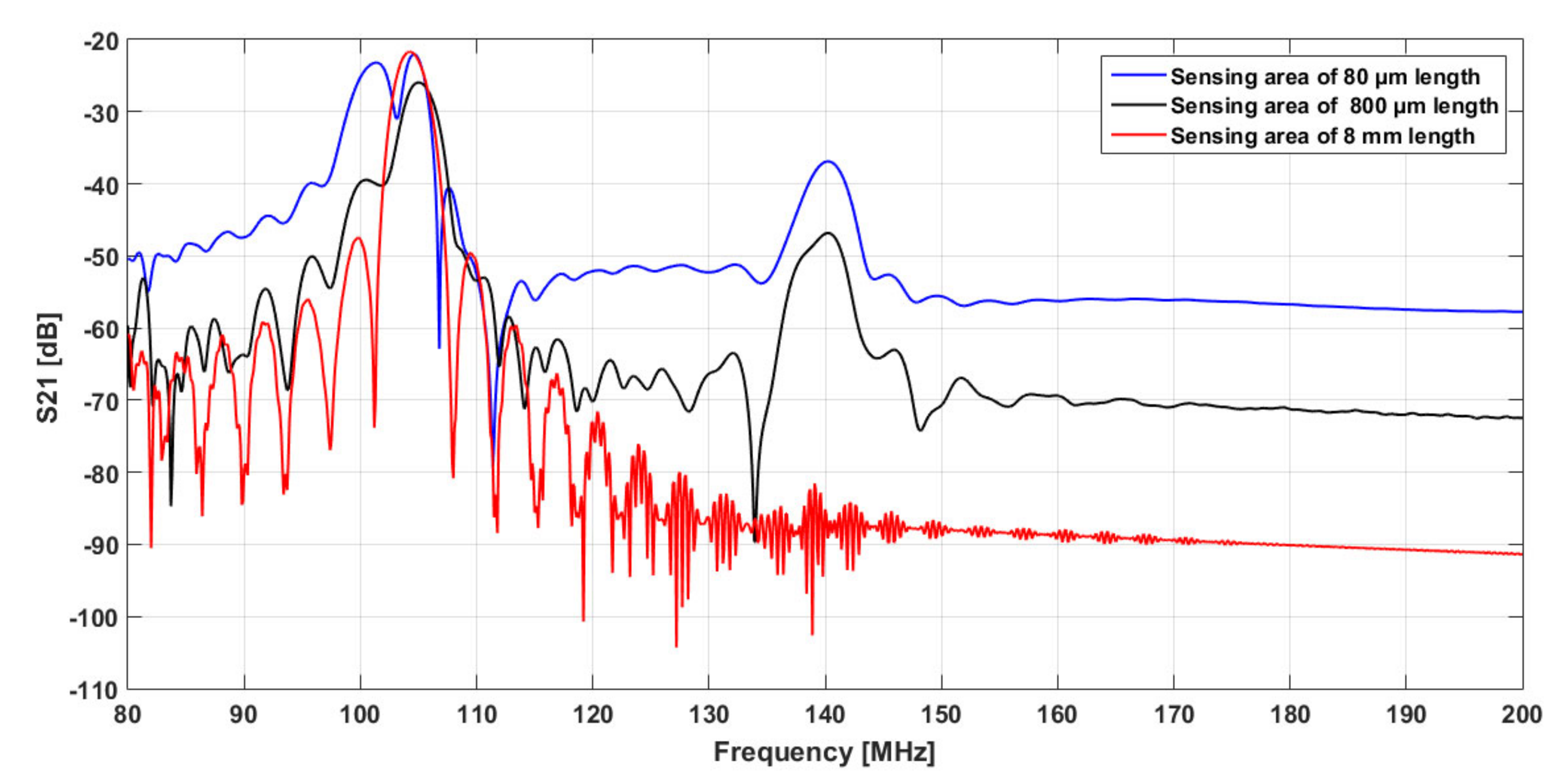

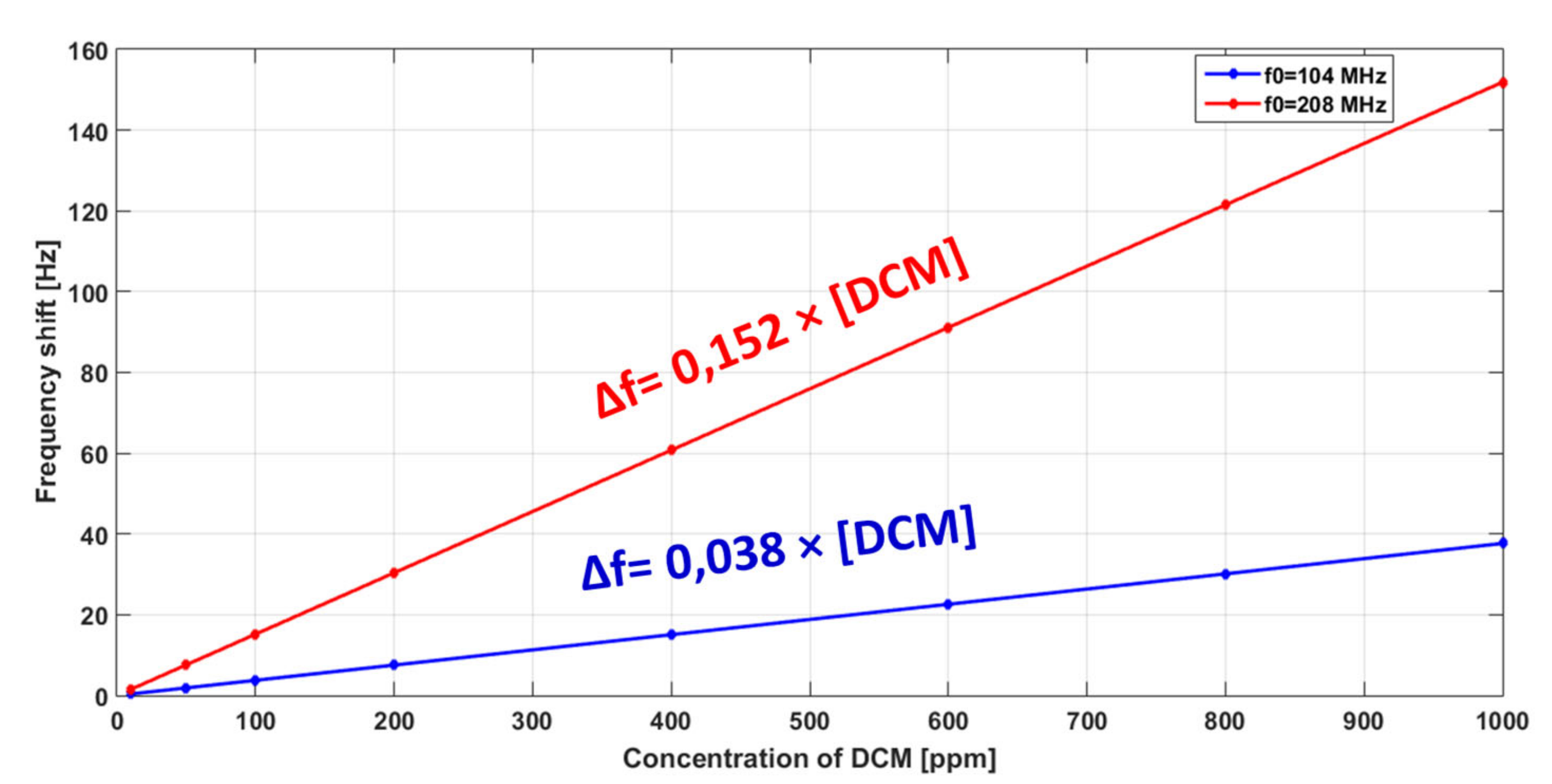
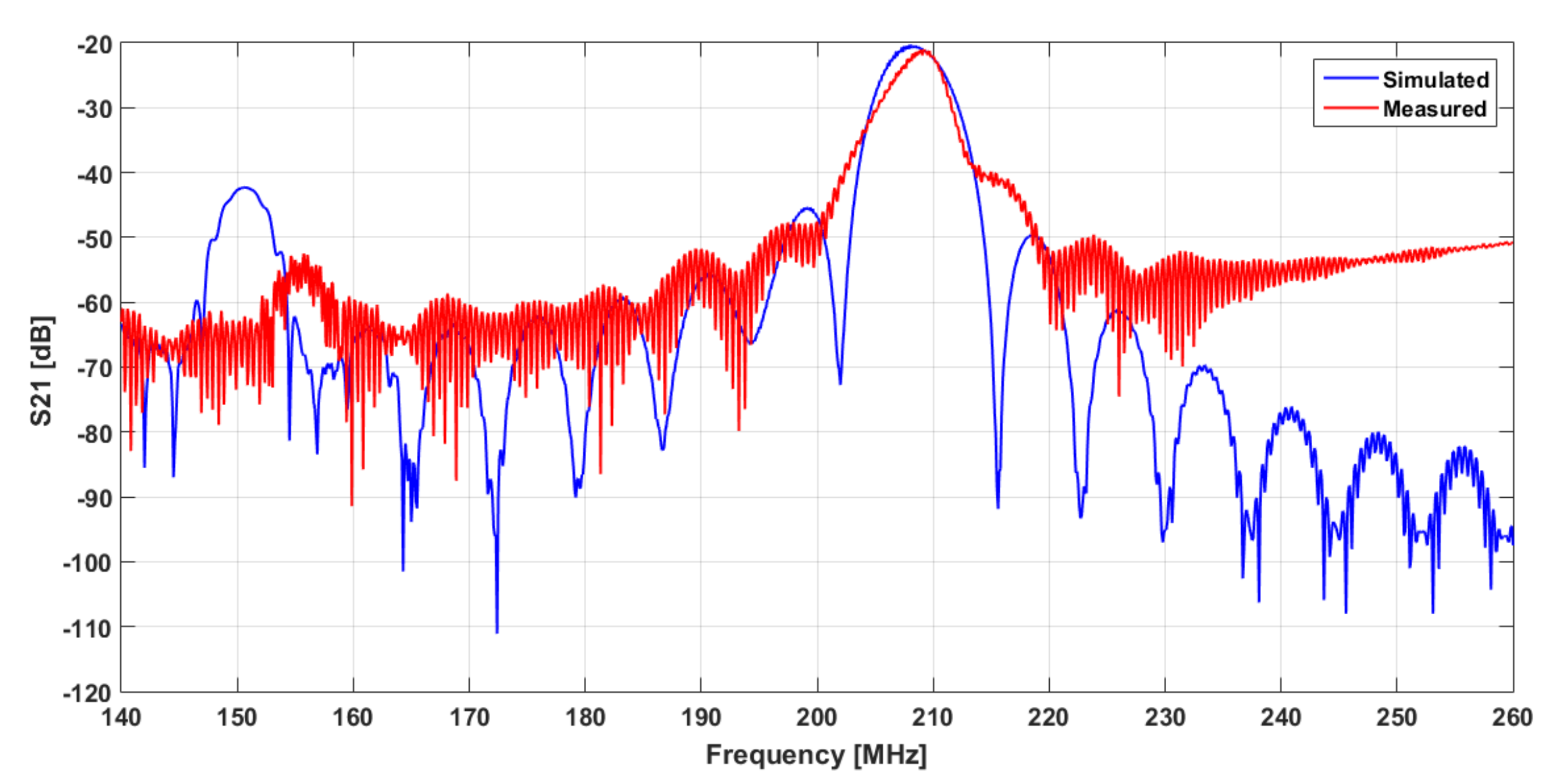
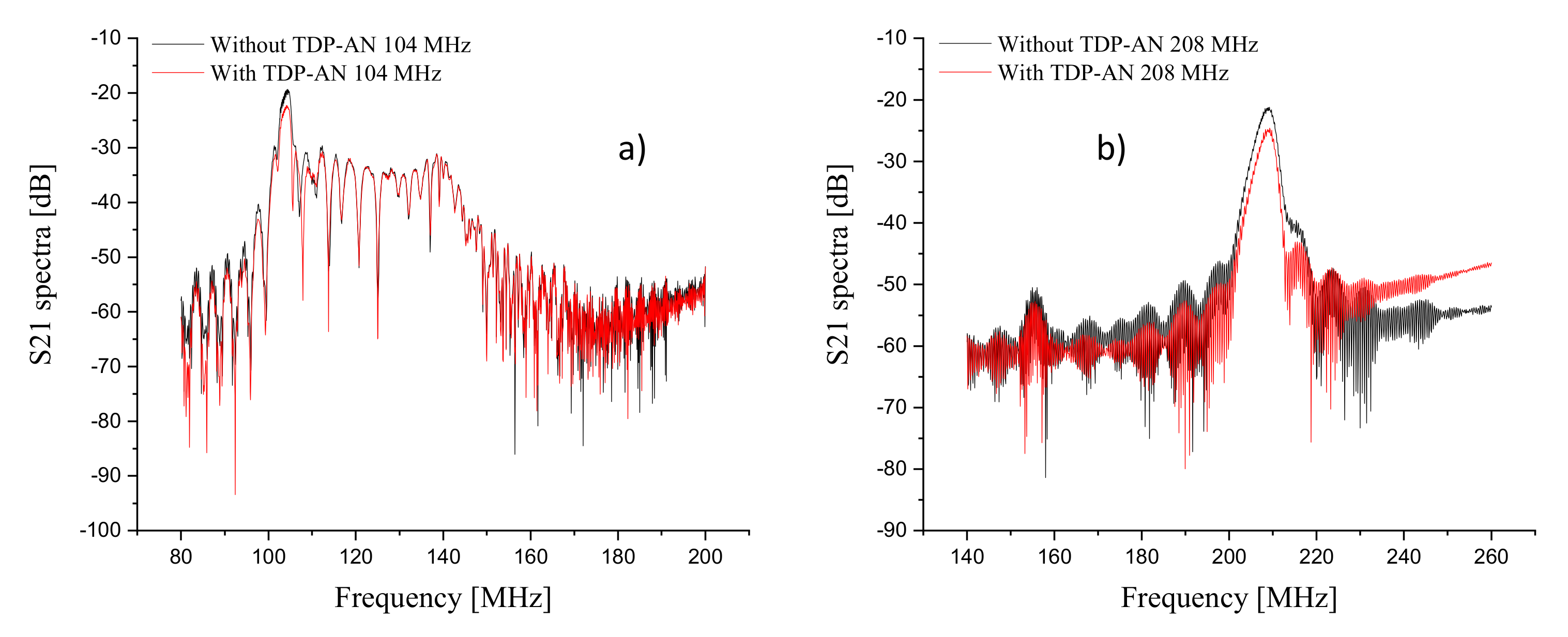
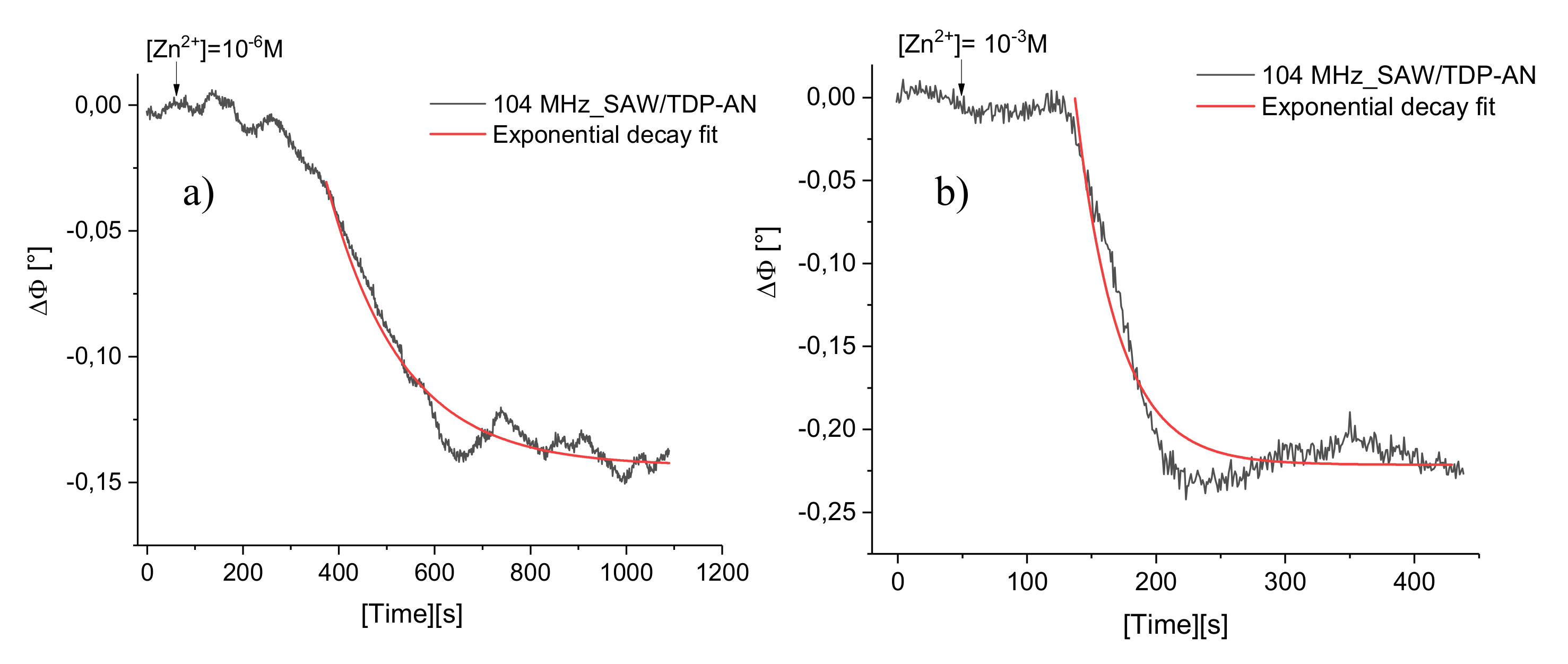
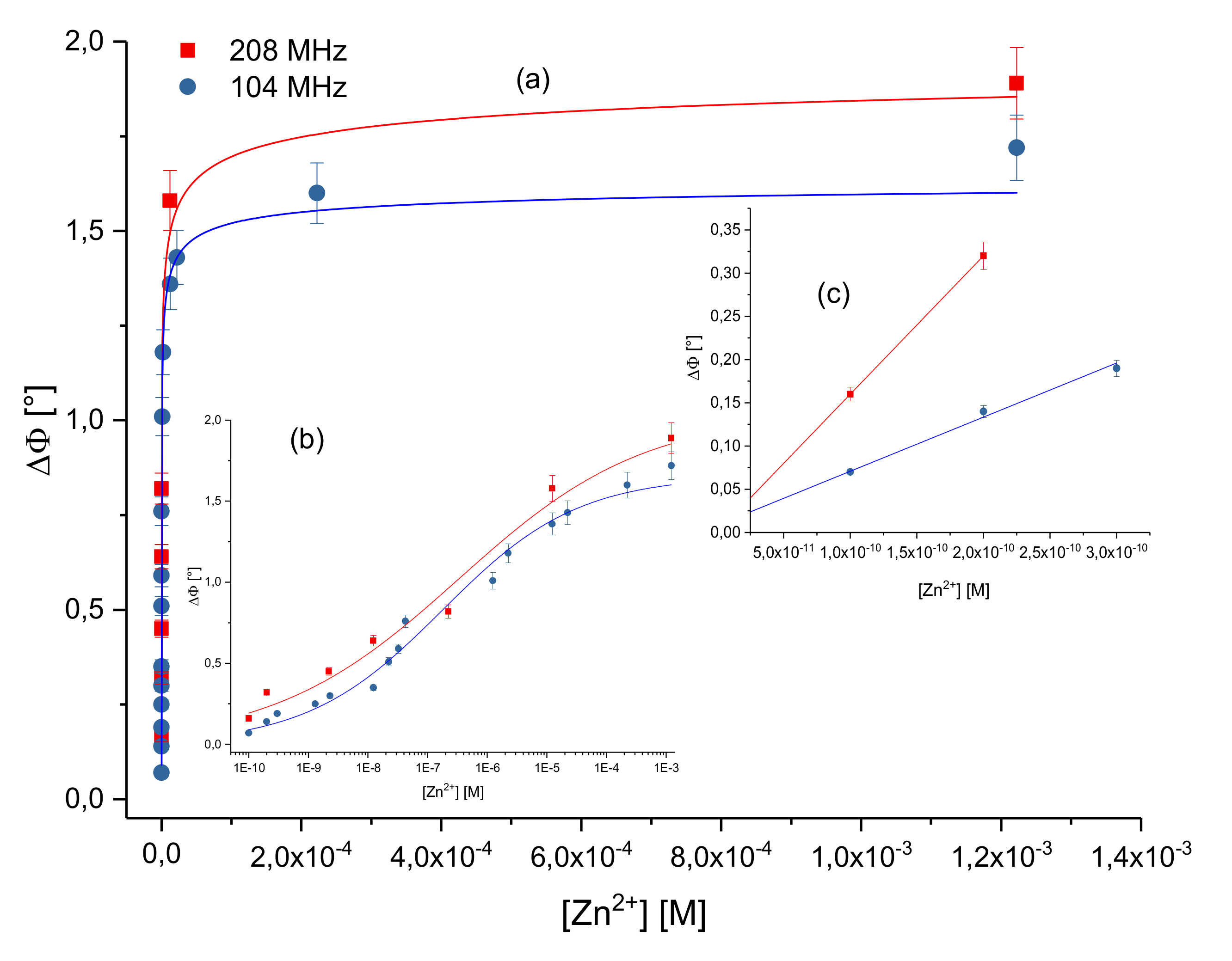
| Parameters | Values |
|---|---|
| Electromechanical coupling coefficient (K2) | 0.047 |
| Surface wave velocity | 4160 m·s−1 |
| Fast bulk wave velocity | ≈5600 m·s−1 |
| Operating frequency (f0) | 104 MHz |
| Number of finger pairs (Np) | 30 |
| Aperture (Wa) | 2000 μm |
| Length of delay line (D) | 8010 μm |
| Source and load impedance (Zs et ZL) | 50 Ω |
| Capacitance per unit length for a pair of fingers (Cs) | 50 pF/m |
| Total static capacitance (CT) | 6.04 pF |
© 2020 by the authors. Licensee MDPI, Basel, Switzerland. This article is an open access article distributed under the terms and conditions of the Creative Commons Attribution (CC BY) license (http://creativecommons.org/licenses/by/4.0/).
Share and Cite
Achour, B.; Attia, G.; Zerrouki, C.; Fourati, N.; Raoof, K.; Yaakoubi, N. Simulation/Experiment Confrontation, an Efficient Approach for Sensitive SAW Sensors Design. Sensors 2020, 20, 4994. https://doi.org/10.3390/s20174994
Achour B, Attia G, Zerrouki C, Fourati N, Raoof K, Yaakoubi N. Simulation/Experiment Confrontation, an Efficient Approach for Sensitive SAW Sensors Design. Sensors. 2020; 20(17):4994. https://doi.org/10.3390/s20174994
Chicago/Turabian StyleAchour, Bilel, Ghada Attia, Chouki Zerrouki, Najla Fourati, Kosai Raoof, and Nourdin Yaakoubi. 2020. "Simulation/Experiment Confrontation, an Efficient Approach for Sensitive SAW Sensors Design" Sensors 20, no. 17: 4994. https://doi.org/10.3390/s20174994
APA StyleAchour, B., Attia, G., Zerrouki, C., Fourati, N., Raoof, K., & Yaakoubi, N. (2020). Simulation/Experiment Confrontation, an Efficient Approach for Sensitive SAW Sensors Design. Sensors, 20(17), 4994. https://doi.org/10.3390/s20174994








